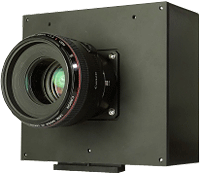By the light of the silvery moon, Canon’s new full-frame sensor gets quality video
posted Monday, March 4, 2013 at 8:47 AM EDT

Interesting development news crossed our desk this morning from the Japanese headquarters of camera giant Canon. The company says it has developed a new 35mm full-frame CMOS image sensor intended specifically for video capture. If you fancy shooting ambient-light video under the stars, prepare to control your excitement.
With even Full HD video equating to just 2.1 megapixels, the relatively low resolution allows an extremely generous 19 micron pixel size, which is around 7.5 times the size of the pixels in the EOS-1D X. The pixel structure and readout circuitry is also said to further control noise levels. That, suggests Canon, translates to high ISO and low-light performance to match. According to its maker, the new sensor allows "clearly visible" video in light levels down to 0.03 lux, a level at which even the human eye would struggle. By way of comparison, full moonlight is in the region of 0.27 to 1 lux on a clear night.
The new sensor, then, would allow shooting under the light of a crescent moon without additional illumination, as demonstrated in the clip above. Video shot under a full moon looks as bright as day, after boosting sensitivity. Even more impressively, Canon is showing sample footage with an easily-identifiable human face, captured in a room illuminated only by burning incense sticks (0.01 to 0.05 lux).
The new sensor will be of particular interest to astrophotographers. (It may be aimed at video, but that doesn't mean you can't shoot Full HD stills with it, too.) Canon says that, while a typical electron multiplying CCD sensor can capture magnitude six stars, its new chip can manage magnitude 8.5 and above. This, too, is demonstrated in the sample video, which also has a clip of the Geminid meteor shower.
So... why must you temper your enthusiasm? Well, this so far is only a development announcement; no specific product plans are stated. Canon does suggest that it expects to commercialize the chip, but you likely won't be seeing it in your next video SLR any time soon. It's being launched at the Security Show 2013 in Japan, and is expected to be aimed at security, surveillance, medical research, and astronomical / natural observation.